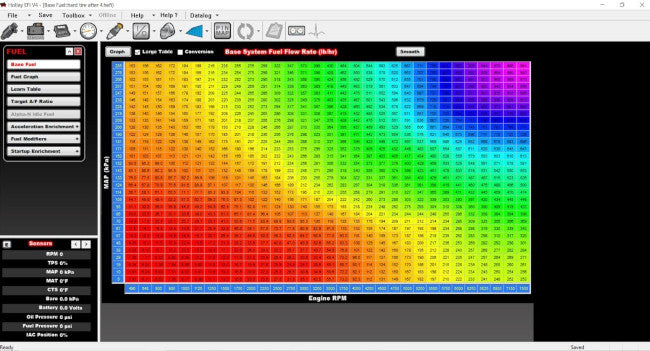by: Benjamin Strader ©2004
1. Tuning EFI Systems on a Chassis Dyno
Sometimes when you are tuning an engine that is already in a vehicle on a chassis dyno, a lot of strange things can happen that you should be aware of.
First of all, it is important to keep a perspective on all the things that are happening. It can be very difficult to keep track of engine temperature, manifold pressure, air/fuel ratios, engine torque and horsepower readings all at the same time. It will take some practice to get comfortable with all of this while the wheels are spinning.
Try to pay attention to things like traction of the tires on the rollers. Many cars that produce big power can easily overpower the amount of tire adhesion to the roller, and this will dramatically affect the amount of power the dyno records. If you aren't applying all the power to the roller, it can't tell how much power you are making. On a dyno chart, this can normally be seen as an abnormal spike in engine speed and a corresponding drop in power and torque readings.
It is also important to remember that if you are recording Air/Fuel ratios with anything but the most high-speed exhaust analyzers that it is very common to get false readings when the engine accelerates too quickly. This happens because the engine speed changes so rapidly that the exhaust meter cannot update its sampling rate quick enough. By the time it processes a sample and displays it, the engine can be well beyond that operating range and be dangerously lean, or grossly over fueled. This makes it nearly impossible to record data and make accurate changes to the calibration.
Soft compound racing slicks and/or too little tire pressure can cause the tire to deform on the roller and actually decrease surface contact! Use a good radial street compound tire and strap the vehicle down tightly against the rollers.
2. Tuning Ignition Timing Tables
Whether you are tuning an engine on an engine dyno or a chassis dyno, you should always make sure that it gets tuned to the proper amount of ignition timing.
The best way to do this is to use a steady state holding pattern on the dyno and hold the engine to a specific RPM. Then load the engine to whatever site you wish to tune and record the instantaneous power readings.
When you make a change to add or subtract ignition timing, you will normally see a corresponding change in power output.
Using an onboard or aftermarket Knock sensor to check for detonation is the easiest way to find the maximum allowable ignition advance. However, if you do not have access to one, here is another way to get pretty close.
Advance the timing until maximum power is reached and begins to fall off when more timing is added. From there, back off the ignition advance one or two degrees and set it there.
Once you have made a few hard pulls on the engine at this setting, shut it off and remove the spark plugs. Inspect them for obvious signs of detonation or erosion. Pay careful attention to the J-shaped ground strap. You will notice that somewhere on the strap it begins to change color.
Ideally, when the proper timing is set, there will be enough heat in the combustion chamber to make the color change at about the center of the strap. If it changes more out towards the end of the strap, then there is not enough heat, and more advance is needed. Conversely, if the color change is near the bottom where the strap joins the plug, then take some ignition advance out in order to start the burn later and transfer more heat out the exhaust!
3. Using Ignition Timing to Stabilize Idle
When tuning a small displacement engine with very large injectors, you may have trouble establishing a good solid idle. This occurs because some ECUs do not have the injector driver strength to open and close these injectors for a short enough period of time and remain consistent enough to control the fuel.
Other than using a better quality fuel injection computer than what you already have, (assuming you've already purchased one), there are a few tricks to help you along.
First, always make sure that your ECU is getting full battery voltage, if not more from the alternator. The ECU will have a much harder time staying consistent if the supply voltage is not up to par.
Second, use a little more ignition advance at idle than normal to help the engine produce slightly more torque and keep itself running a little better.
Lastly, try lowering the base fuel pressure just slightly to take the pressure off of the magnet coil inside of it. The less pressure it has to open the valve against, the easier time the injector driver will have when trying to open it. You don't want to go down too low though, or poor fuel atomization can occur and make the poor idle situation even worse!
I have found that some of the better brand ECUs such as Motec, Autronic, and EFI Technology have very little problems controlling very large injectors on even the smallest engines. If you are looking at purchasing a fuel injection system for your project and idle quality is a concern, these might be good systems to look into. It is often beneficial to look at all the pros and cons of owning a particular brand of fuel injection system other than initial cost alone.
4. Using Oxygen Sensors
Tuning a modern fuel injected engine is nearly impossible without the use of an oxygen sensor. There are a few points to consider when finding a suitable place to mount the sensor in the exhaust manifold.
First, always try to mount the sensor so that it collects mixture data from as many cylinders as possible. Try to avoid having the sensor only get one cylinder's exhaust whenever possible. On an with the cylinders laid out in a V configuration such as a V6 or V8 it is most desirable to place the sensor in the exhaust collector where at least half the cylinders come together.
On a small four-cylinder engine using a turbocharger, it is common to place the sensor just before the inlet of the turbo. This a good place to collect exhaust mixture information, however it is possible to overheat the sensor in this location. Most exhaust gas oxygen sensors can withstand up to about 800 degrees Celsius, but at times a turbocharged engine can easily exceed these temperatures.
Also be sure that there are no openings or cracks in the exhaust system ahead of the oxygen sensor. This can introduce fresh air into the exhaust stream and cause the air/fuel ratios to seem leaner than they are.
Lastly, some modern cars are now using air injection pumps to introduce fresh air into the exhaust stream in order to reduce exhaust emissions. This fresh air can also easily fool the oxygen sensor into thinking the engine's actual air/fuel ratio is leaner than it really is. Be sure to disable any such devices before you begin your tuning.
Always protect your sensor from chemicals such as sealants, and remember that using leaded fuel will drastically shorten the life of your sensor.
5. Back to the Basics
When I was young and just starting out tuning engines an old man said to me "ninety percent of all your carburetor problems will be found in the distributor". At the time, I thought he was just a kooky old man. After years of tuning, my own experience seems to have proven him right. Many tuning issues with both carburetors, and modern fuel injection systems are mistakenly blamed on the fuel system.
One thing to watch out for when tuning an engine using a modern fuel injection system is false information from an oxygen sensor when an engine misfires.
When an ignition event fails to happen, or the engine "misfires", the oxygen sensor will want to read a leaner mixture than what really exists. This is due to the fact that the oxygen sensor can only read burned hydrocarbons. When the engine misfires, the unburned fuel doesn't get recognized by the sensor, so it seems that there is a large excess of oxygen in the exhaust system.
Many novice tuners immediately begin to add fuel to the base fuel tables in an attempt to correct a lean mixture induced misfire. Not only does this usually not correct the problem, it often serves to make matters worse. Having too much fuel can also induce a misfire.
Always be sure that the ignition system is in good working order. Visually inspect spark plug gaps and set them according to the manufacturer's recommendations. Also check that the spark plug wires are not burned or melted by the hot exhaust manifolds and check them for signs of wear.
It's also a good idea to check all the power and ground supply wires to the ignition system and the high voltage leads to the ignition coils.
I have found that going back to the basics and thoroughly inspecting the ignition system will almost always rectify the problem!
ABOUT EFI UNIVERSITY Southern California based, EFI University (www.efi101.com) offers classes for individuals who wish to gain professional knowledge about high performance fuel injection systems in a structured environment! EFI University offers the most popular EFI-101 class, the challenging EFI Advanced class, and a Wiring Harness Workshop.
Benjamin M Strader, Senior Instructor at EFI University and author of "How to Build and Tune Custom EFI Systems", has over 8 years of experience tuning and troubleshooting aftermarket electronic fuel injection systems. Recognizing the need for more education throughout the performance marketplace, Ben has formed EFI University, a company dedicated to teaching others about the correct use and implementation of aftermarket fuel injection systems!




Leave a comment
This site is protected by hCaptcha and the hCaptcha Privacy Policy and Terms of Service apply.